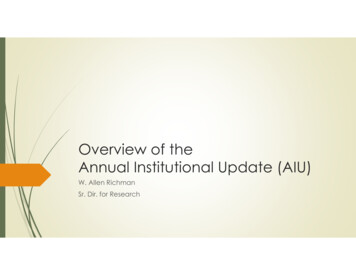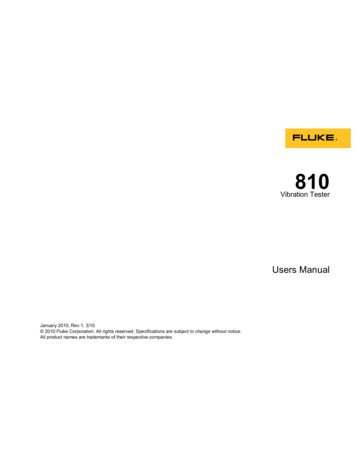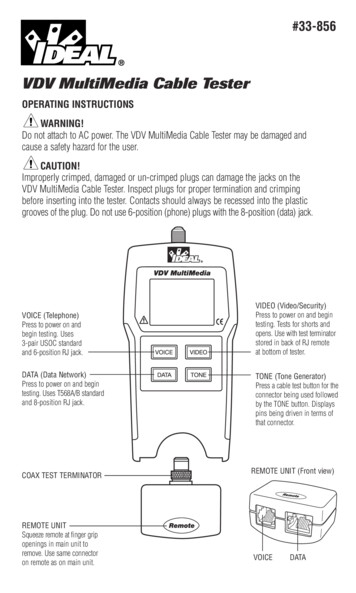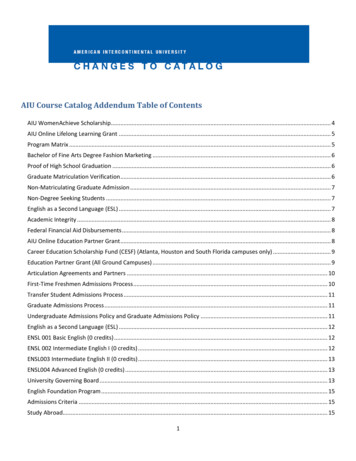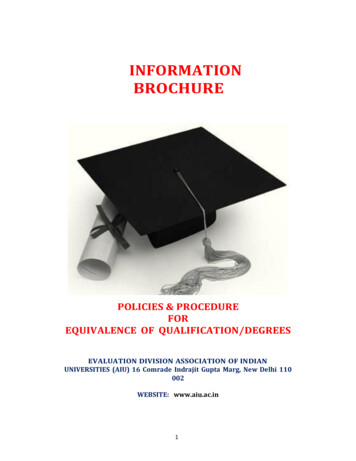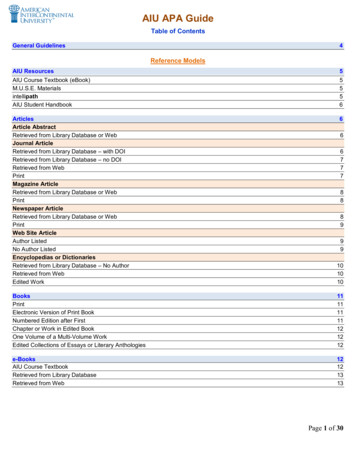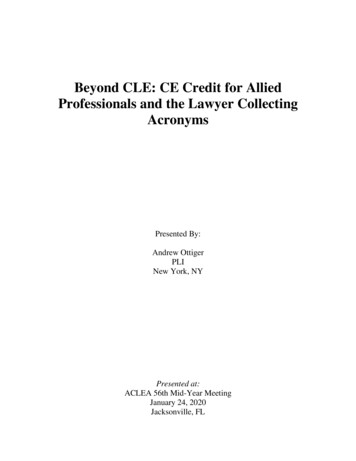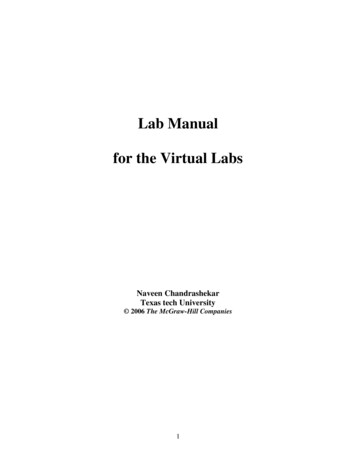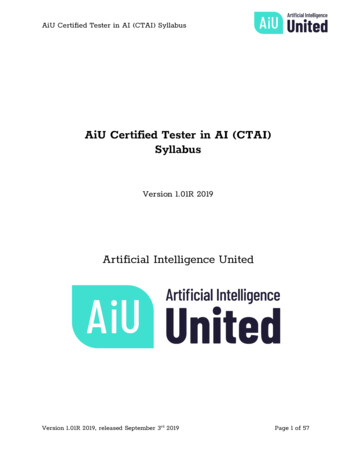
Transcription
AiU Certified Tester in AI (CTAI) SyllabusAiU Certified Tester in AI (CTAI)SyllabusVersion 1.01R 2019Artificial Intelligence UnitedVersion 1.01R 2019, released September 3rd 2019Page 1 of 57
AiU Certified Tester in AI (CTAI) SyllabusCopyright NoticeThis document may be copied in its entirety, or extracts made, if the source isacknowledged.All Artificial Intelligence United syllabus and linked documents including thisdocument are copyright of Artificial Intelligence United (hereafter referred to asAiU).The material authors and international contributing experts involved in thecreation of the AiU resources hereby transfer the copyright to ArtificialIntelligence United (AiU). The material authors, international contributingexperts and AiU have agreed to the following conditions of use: Any individual or training company may use this syllabus as the basis fora training course if AiU and the material authors are acknowledged as thecopyright owner and the source respectively of the syllabus, and theyhave been officially recognized by AiU. More regarding recognition isavailable via: https://www.ai-united.org/recognition Any individual or group of individuals may use this syllabus as the basisfor articles, books, or other derivative writings if AiU and the materialauthors are acknowledged as the copyright owner and the sourcerespectively of the syllabus.Thank you to the main authors: Vipul Kocher, Saurabh Bansal, Srinivas Padmanabhuni and SonikaBenganiThank you to the co-authors Rik Marselis and José M. Díaz DelgadoThank you to the review committeeAlbert Tort, Alfonso Fernández, Amit Dang, Ana Laura Ochoa Moreno, AndreasHetz, Ángel Rayo Acevedo, Aurelio Gandarillas, Baris Sarialioglu, Björn Lemke,Christine Green, Daniel Garcia Castillo, Daniel Tolosa, Dario Iván RosasMiranda, Durga Mohapatra, Emilie Potin-Suau, Erik van Veenendaal, GirishNuli, Girts Baltaisbrencis, Guino Henostroza, Gustavo Márquez Sosa, GustavoTerrera, Héctor Ruvalcaba, Javier Alejandro Chávez Crivelli, Jeff Nyman, JoelOliveira, José Antonio Rodríguez Gómez, Juan Pablo Rios Alvarez, JulieVersion 1.01R 2019, released September 3rd 2019Page 2 of 57
AiU Certified Tester in AI (CTAI) SyllabusGardiner, Kimmo Hakala, Kristine Corbus, Kyle Alexander Siemens, LorenaParra Rubio, Maarten-Jan van Gool, Manuel Fischer, Márton Görög,Maximiliano Mannise, Melissa Pontes, Miaomiao Tang, Michaël Pilaeten, MichelDussouchaud, Nadia Soledad Cavalleri, Nora Alriyes, Paweł Noga, PetrNeugebauer, Ralf Pichler, Ram Shanmugam, Raúl Hussein Galindo, RichardSeidl, Sammy Kolluru, Samuel Ouko, Santiago de Jesús González Medellín,Sebastia Małyska, Sergio Emanuel Cusmai, Serge Wolf, Shantel YaniqueStewart, Silvia Nane, Sunil Godse, Siva Prasad. B, Søren Wassard, Tariq King,Tetsu Nagata, Vikas Dhaka, Tom Van Ongeval, Werner Lieblang, WimDecoutere, Yogesh Ahuja, Young jae ChoiRevision HistoryVersionAiU A 2019AiU B 2019AiU 1.0R 2019Version 1.01R 2019DateMarch 2, 2019May 8, 2019July 16, 2019September 3, 2019Version 1.01R 2019, released September 3rd 2019RemarksFirst beta releaseSecond beta releaseFirst releaseSecond ReleasePage 3 of 57
AiU Certified Tester in AI (CTAI) SyllabusTable of ContentsBusiness Outcomes7Learning Objectives/Cognitive Levels of Knowledge7Prerequisites8Chapter 1 - Introduction to Artificial Intelligence91.1 Artificial Intelligence (AI)101.1.1 Definition of Artificial Intelligence (AI)101.1.2 Types of AI101.2 Machine Learning (ML)111.2.1 Definition of ML111.2.2 Supervised Learning - Classification and Regression121.2.3 Unsupervised Learning – Clustering and Association121.2.4 Reinforcement Learning131.3 Deep Learning (DL)1.3.1 Deep Learning and the Types of Neural Networks1.4 Stages of the ML Process1414151.4.1 Stages of the ML Process – CRISP-DM Process151.4.2 Steps for the Identification of the ML Problem Type16Chapter 2 - Overview of Testing AI Systems2.1 AI Testing Phases2.1.1 Offline and Online Testing of AI Systems2.2 AI vs. Non-AI Testing2.2.1 Testing of AI systems vs. Traditional (non-AI) Systems2.3 AI Quality Characteristics1717171818192.3.1 Quality Characteristics for Evaluating AI Systems192.3.2 Extended Quality Characteristics Specific to AI20Chapter 3 - Offline Testing of AI Systems223.1 Data Preparation and Preprocessing243.1.1 Steps of Data Preparation and Preprocessing243.1.2 Data Preparation243.1.3 Processing of Unstructured Data (Images)253.1.4 Processing of Unstructured Data (Text)253.1.5 Data Imputation253.1.6 Data Visualization26Version 1.01R 2019, released September 3rd 2019Page 4 of 57
AiU Certified Tester in AI (CTAI) Syllabus3.1.7 Anomaly/Outliers Detection263.1.8 Outliers Detection Techniques273.1.9 Dimensionality Reduction273.2 Metrics283.2.1 Role of Metrics283.2.2 Metrics for Supervised and Unsupervised Learning293.2.3 Inertia and Adjusted Rand Score293.2.4 Support, Confidence and Lift metrics303.2.5 Confusion Matrix313.2.6 Accuracy, Precision, Recall, Specificity and F1-Score313.2.7 RMSE and R-Square323.3 Model Evaluation323.3.1 Training, Validation and Testing Datasets323.3.2 Underfitting and Overfitting333.3.3 Cross-validation methods343.4 Analytics3.4.1 Types of Analytics3434Chapter 4 - Online Testing of AI Systems364.1 Architecture of an AI application364.1.1 Components of an Intelligent Application and their Testing Needs364.1.2 Interaction of AI and Non-AI Parts394.2 Linguistic Analysis Test Design Method414.2.1 Linguistic Analysis-Based Test Design414.3 Testing AI systems424.3.1 Test a Chatbot42Chapter 5 - Explainable AI445.1 Explainable AI (XAI)445.1.1 Explainable AI and its Need445.1.2 LIME455.1.3 CAM for Neural Networks46Chapter 6 - Risks and Test Strategy for AI Systems6.1 Risks in testing AI47476.1.1 Risks of Testing AI Systems476.1.2 Risk of Using Pre-Trained Models486.1.3 Risk of Concept Drift (CD)48Version 1.01R 2019, released September 3rd 2019Page 5 of 57
AiU Certified Tester in AI (CTAI) Syllabus6.1.4 Challenges of AI Test Environment6.2 Test Strategy6.2.1 Test Strategy for Testing AI ApplicationsChapter 7 - AI in Testing7.1 AI for Software Testing Life Cycle (STLC)49494952527.1.1 AI for STLC Methods527.1.2 AI for Reporting and Smart Dashboards537.2 AI based automation tools7.2.1 ToolsReferencesVersion 1.01R 2019, released September 3rd 2019545455Page 6 of 57
AiU Certified Tester in AI (CTAI) SyllabusBusiness OutcomesBO-1BO-2BO-3BO-4BO-5BO-6BO-7BO-8Understand current trends, industry applications of ArtificialIntelligence (AI) using Machine Learning (ML).Compare different implemented ML algorithms to help choose themost suitable one.Evaluate models for both supervised and unsupervised learning.Design and execute test cases for AI systems.Use various methods for bringing transparency into model workings.Define a test strategy for testing of AI systems.Understand where AI can be used in manual testing and in testautomation.Use AI based test execution tools to automate tests.Learning Objectives/Cognitive Levels of KnowledgeLearning objectives (LOs) are brief statements that describe what you areexpected to know after studying each chapter. The LOs are defined based onBloom’s modified taxonomy as follows: K1: Remember. Some of the action verbs are Remember, Recall, Choose,Define, Find, Match, Relate, Select K2: Understand. Some of the action verbs are Summarize, Generalize,Classify, Compare, Contrast, Demonstrate, Interpret, Rephrase K3: Apply. Some of the action verbs are Implement, Execute, Use, ApplyFor more details of Bloom's taxonomy please refer to [BT1] and [BT2] inReferences.Hands-on ObjectivesHands-on Objectives (HOs) are brief statements that describe what you areexpected to perform or execute to understand the practical aspect of Learning.The HOs are defined as follows: HO-0: Live demo of an exercise or recorded video HO-1: Guided exercise. The trainees follow the sequence of stepsperformed by the trainer HO-2: Exercise with hints – Exercise to be solved by the trainee utilizinghints provided by the trainer HO-3: Unguided exercises without hintsVersion 1.01R 2019, released September 3rd 2019Page 7 of 57
AiU Certified Tester in AI (CTAI) SyllabusPrerequisitesMandatory NoneRecommended ISTQB Foundation level or equivalent Basic knowledge of any programming language - Java/Python/R Basic knowledge of statistics Some software development or testing experienceVersion 1.01R 2019, released September 3rd 2019Page 8 of 57
AiU Certified Tester in AI (CTAI) SyllabusChapter 1 - Introduction to Artificial IntelligenceKeywordsartificial intelligence, machine learning, supervised learning,unsupervised learning, supervised classification, supervisedregression, unsupervised clustering, unsupervised association,reinforcement learning, deep learning, neural networks, CRISP-DM,ML life cycle.LO-1.1.1K2 Explain artificial intelligence (AI).LO-1.1.2K1LO-1.2.1Explain machine learning (ML) and the fact that ML is oneK2 way to achieve AI.LO-1.2.2Explain Supervised ML and the difference betweenK2 Supervised Classification and Regression.LO-1.2.3Explain Unsupervised ML and compare UnsupervisedK2 Clustering and Association.Recall various types of AI – Narrow, General and Super AI.Recall the definition and applications of ReinforcementLearning (RL).LO-1.2.4K1LO-1.3.1K2 Explain Deep Learning (DL) and types of Neural Networks.LO-1.4.1Explain various stages of CRISP-DM – a process for the MLK2 lifecycle.LO-1.4.2Apply the steps involved in identifying the appropriate MLK3 problem type.Version 1.01R 2019, released September 3rd 2019Page 9 of 57
AiU Certified Tester in AI (CTAI) Syllabus1.1 Artificial Intelligence (AI)Artificial intelligence is the intelligence acquired by a machine to solveproblems usually solved by humans.IBM Watson, MS Cortana, Apple Siri, Autonomous Vehicles are some of theexamples of a large number of existing well-known AI applications.1.1.1 Definition of Artificial Intelligence (AI)LO-1.1.1K2 Explain artificial intelligence (AI).AI is an art of creating machines that perform functions that requireintelligence when performed by people. [KUR]Al is playing a leading role inhealthcare, manufacturing, e-commerce, retail, social Media, logistics and otherindustry sectors. Some of the reasons for increasing use of AI are the rise inthe processing power, availability of data, and new technologies. AI use casesspan from monitoring one’s home, determining which stock to invest in, helpingto decide which recipe to make to helping in choosing your life partner!AI is an umbrella term which covers the science of making machinesintelligent, whether it is a robot, a refrigerator, a television, a car, a firmware ora software component. ML is the subset of AI. ML and AI are often usedinterchangeably, but they are not the same thing.ML is explained in more details in 1.2 Machine Learning (ML)1.1.2 Types of AILO-1.1.2K1Recall various types of AI – Narrow, General and Super AI.AI can broadly be categorized as Narrow, General or Super AI. Narrow AI: Machines that are programmed for carrying out a specifictask with limited context. For example, game playing machines, voiceassistants and all AI currently. General AI: Machines with general cognitive abilities are popularly calledas Strong AI cases. These AIs can reason and understand theirenvironment as humans do, and act accordingly. For instance, commonVersion 1.01R 2019, released September 3rd 2019Page 10 of 57
AiU Certified Tester in AI (CTAI) Syllabus sense reasoning. Currently, General AI has not been realized and nobodyknows when or if it will become a reality at all.Super AI: Machines that are capable of replicating human thoughts, ideasand emotions. It is that super state of intelligence where machines willbecome smarter and wiser than humans. Considering the current state ofAI developments, Super AI will not become a reality anytime soon.1.2 Machine Learning (ML)1.2.1 Definition of MLLO-1.2.1Explain machine learning (ML) and the fact that ML is oneK2 way to achieve AI.Arthur Samuel defined ML as, “A field of study that gives computers the abilityto learn without being explicitly programmed.” ML systems learn and improvewith experience, and, with time, refine a model that can be used to predict theoutcome of questions, based on the previous learning [JB1].Beyond ML, AI uses concepts of knowledge representation and reasoning forhandling diverse scenarios. Notion of searching, scheduling and optimizing fallunder the scope of AI, but not necessarily ML.Some of the technologies used to accomplish AI are: Machine Learning (ML)Natural Language Processing (NLP)RoboticsSpeech ProcessingComputer VisionThere are a few ways in which ML algorithms can be categorized: Supervised LearningUnsupervised LearningReinforcement LearningVersion 1.01R 2019, released September 3rd 2019Page 11 of 57
AiU Certified Tester in AI (CTAI) Syllabus1.2.2 Supervised Learning - Classification and RegressionLO-1.2.2Explain Supervised ML and the difference betweenK2 Supervised Classification and Regression.Supervised Learning: In this kind of learning, the model learns from labeleddata during the training phase. The labeled data acts as a trainer/supervisor forthe mapping function which infers the relationship between input data and theoutput label during the training. During the testing phase, the mapping functionis then applied to a new set of unseen data to predict the output which is alsolabeled. The model is deployed once the output accuracy level is satisfactory.Problems solved by Supervised Learning are further divided into twocategories:Classification: When the problem requires classifying an input into one of afew pre-decided classes, supervised learning is used. This kind of model isused when the output data is discrete or when the output falls among thenumber of classes fed during training. Face recognition or object detection inan image are examples of problems that can use classification. Some otherapplications of classification are spam detection (spam or no spam), thediagnosis of a disease on the basis of the likes of an X-ray, correctidentification of road signs by a driver assistance system, etc. Some of thecommonly used algorithms for classification are logistic regression, nearestneighbor, support vector machine, and neural nets.Regression: When the output data is continuous or numeric in nature, e.g.,predicting the age/weight of a person, predicting the future price of the stock,etc., regression learning is used. The most commonly used algorithm for thiskind of problems is linear regression, a simple algorithm which explains therelation between inputs and the output and inputs as a linear equation. Someother algorithms are logistic regression, support vector machines, Lassoregression, etc.1.2.3 Unsupervised Learning – Clustering and AssociationLO-1.2.3Explain Unsupervised ML and compare UnsupervisedK2 Clustering and Association.Version 1.01R 2019, released September 3rd 2019Page 12 of 57
AiU Certified Tester in AI (CTAI) SyllabusUnsupervised Learning: Clean, labeled data are not readily available all thetime, so that certain problems need to be solved without an explicitly labeledtraining set. This kind of ML where no labeled data is provided explicitly iscalled Unsupervised Learning. The objective in such problems is to learn thepattern and structure of input data without any associated labels.Unsupervised Learning is further classified in the following two methods, basedon the type of outputs:Clustering: This Unsupervised Learning model groups the input data based onsome common characteristics or attributes. Input data with similar attributes(not labeled) are grouped in one cluster. Thus, the outputs are clusters of inputdata. For instance, customer segmentation in market analysis.Association: Association Rule Mining finds interesting relationships ordependencies among the data attributes. The discovery of interestingassociations provides a source of information often used for decision making.For example, market-basket data analysis, product recommendation systembased on learnings derived from customer shopping behavior are goodexamples of association rule-based modeling.1.2.4 Reinforcement LearningLO-1.2.4K1Recall the definition and applications of ReinforcementLearning (RL).It is a type of ML where an agent (algorithm) learns by interacting with theenvironment in an iterative manner and thereby learns from experience. Theagent is rewarded when it makes a right decision and penalized when it makesa wrong one. This reward and penalty-based learning is thus defined as‘reinforcement learning’ (RL). Setting up the proper environment, choosing theright strategy for the agent to meet the desired goal, and designing a rewardfunction, are some of the key challenges in implementing RL. Robotics,Autonomous Vehicles, and Chatbots are examples of applications that can useRL.Version 1.01R 2019, released September 3rd 2019Page 13 of 57
AiU Certified Tester in AI (CTAI) Syllabus1.3 Deep Learning (DL)1.3.1 Deep Learning and the Types of Neural NetworksLO-1.3.1Explain Deep Learning (DL) and the types of Neural NetworksK2 (NN).Deep Learning (DL) refers to the systems gaining experience from massive datasets. DL uses Artificial Neural Networks (ANN) to analyze large data sets, e.g.Autonomous Vehicles, Large Text Processing, and Computer Vision applicationsamong others. [AG1]DL is a subset of ML and ML is a subset of AI. DL uses the same types oflearning (Supervised, Unsupervised and Reinforcement Learning) as ML.Artificial Neural Networks: Artificial Neural Networks (ANN) are inspired bythe architecture of the human brain. ‘Neurons’, as the basic unit of ANN, actupon the input stimulus and produce the output signal. The input goes throughthe layers of activation functions to generate the output. These layers form amesh like network.Every ANN has at least two layers – input and output layers. All the layersbetween these two layers are called hidden layers. Some of the various types ofneural networks are:Deep Neural Network (DNN): Deep Neural Network (DNN) is an ANN withtwo or more hidden layers.Convolutional Neural Network (CNN): Convolutional Neural Network (CNN)is an ANN that emerged from the study of the brain’s visual cortex, and theyhave been used in image recognition since the 1980s. Unlike other neuralnetworks, CNNs work directly on input images without serializing/ vectorizingan input image and extracting features by filters. CNNs power image searchservices, autonomous vehicles, automatic video classification systems, andmore.Recurrent Neural Network (RNN): These ANNs can predict the future of timeseries problems. They follow a sequential approach on series of input data ofarbitrary length rather than inputs of fixed length as in other neural networks.Each input and output are independent of all the other layers. The feedbackfrom the output layer is fed to the same network recurrently, till the right levelof confidence is achieved. RNNs can analyze time series data such as stockVersion 1.01R 2019, released September 3rd 2019Page 14 of 57
AiU Certified Tester in AI (CTAI) Syllabusprices, and tell you when to buy or sell. In autonomous vehicles, they cananticipate trajectories and help avoid accidents.1.4 Stages of the ML ProcessA typical ML project follows all the stages of the Cross Industry StandardProcess for the Data Mining (CRISP-DM) framework – an industry standard,and a flexible framework.1.4.1 Stages of the ML Process – CRISP-DM ProcessLO-1.4.1Explain various stages of CRISP-DM – a process for the MLK2 lifecycle.CRISP-DM has traditionally six stages in the data mining life cycle. It has beencustomized to meet the requirements of ML projects, by adding a seventhstage.The seven stages of the CRISP-DM framework for ML are: [DSC1] [SMU]1. Data acquisition: Gather data from all internal and external sources (forexample databases, CSV files, social media, etc.)2. Data preparation: Clean the raw data and reshape it. New attributes arecreated with feature engineering, a process for creating new variablesfrom existing data. Dimensionality reduction, data imputation, null valuetreatment for the missing values, etc., are some of the methods involvedin data preparation.3. Modeling: Select the model or algorithm, divide the available data intotraining set and testing set. Models are obtained by executing MLalgorithms on the training data set. Use the testing data set to evaluateand enhance the performance of the model until satisfactory performanceis achieved.4. Evaluation: Evaluate the model on various metrics (discussed in 3.2Metrics) and baseline it before it goes for final deployment.5. Deployment: Deploy and monitor the baselined model for metrics in theproduction environment.6. Operations: Carry out regular maintenance and operations. Regenerateand refine the model when the metrics fall below a certain threshold.Version 1.01R 2019, released September 3rd 2019Page 15 of 57
AiU Certified Tester in AI (CTAI) Syllabus7. Optimization: The deployed solution may be replaced due to concept drift(see 6.1.3 Risk of Concept Drift (CD)), as better algorithms becomeavailable, or because of some major failures in performance.Steps 1-4 can be classified as part of the offline phase, the output of which isthe trained model. Steps 5-6 are a part of the online phase, where themodel trained in the offline phase is integrated with the rest of thesystem and deployed in a production environment. The optimization stepinvolves re-execution of steps 1-6.1.4.2 Steps for the Identification of the ML Problem TypeLO-1.4.2Apply the steps involved in identifying the appropriate MLK3 problem type.It is important to understand the problems that we are trying to solve and thetype of learning required to solve those problems. One way we can identify theML problem type is discussed below:1.If the problem involves the notion of multiple states, and involves movesat each state, then explore RL.2. If there is an output variable it is supervised learning.2.1. In the case that the output is discrete and categorical, it is aclassification problem.2.2. In the case that the output is numeric and continuous in nature,then it is a regression problem3. If the output is not provided in the given data set, then explore theunsupervised learning.3.1. If the problem involves grouping similar data, then it is aclustering problem.3.2. If the problem involves finding co-occurring data items, then applyassociation rule mining3.3. If the raw data is unstructured, extracting features automaticallycan be explored with deep learning algorithms.The prerequisite to the above steps is that there should be enough dataavailable for the analysis of the appropriate ML problem type.Version 1.01R 2019, released September 3rd 2019Page 16 of 57
AiU Certified Tester in AI (CTAI) SyllabusChapter 2 - Overview of Testing AI SystemsKeywords: offline phase, online phase, ISO25010Explain the tests performed in AI-ML systems in the trainingLO-2.1.1 K2 (offline) phase and post-training integration (online) phase.LO-2.2.1 K2 Compare testing of AI systems with non-AI systems.Recall the ISO 25010 quality characteristics, especially functionalsuitability, performance efficiency, reliability, maintainability andother parameters such as complexity, scalability and continuouslearning as the parameters to be used for the evaluation of theLO-2.3.1 K1 trained model.Recall the quality characteristics specific to AI testing inaddition to those mentioned in ISO25010 – intelligent behavior,LO-2.3.2 K1 morality and personality.2.1 AI Testing Phases2.1.1 Offline and Online Testing of AI SystemsExplain the tests performed in AI-ML systems in the trainingLO-2.1.1 K2 (offline) phase and post-training integration (online) phase.The ML lifecycle, as described in 1.4 Stages of the ML Process, can be dividedinto two phases: offline and online. Distinct types of tests performed duringthese phases areOffline phase testing: In this phase, the trained model is tested. Variousmetrics are used for evaluation parameters for a trained model to verify howfar it has achieved the objectives. There are different parameters for bothsupervised and unsupervised learning. Typically, the model is tested forfunctional behavior but non-functional characteristics are not tested. Since themodel is deployed in an environment which is different from the trainingenvironment, doing performance testing of the model in this phase does notVersion 1.01R 2019, released September 3rd 2019Page 17 of 57
AiU Certified Tester in AI (CTAI) Syllabusmake much sense. Model training time is a parameter that is evaluated as anon-functional parameter. For models that will need to be retrained frequently,this can be an important parameter. Offline testing is covered in Chapter 3 Offline Testing of AI Systems.Another Important aspect of offline testing is whether it is possible to be ableto explain the behavior of the model. There are various methods and algorithmsthat can be used for it. This aspect of testing is covered in Chapter 5 Explainable AI.Online phase testing: In this phase, the integration of the trained model withthe rest of the system, including all other AI and non-AI components, is tested.Both functional and non-functional tests such as performance tests can beperformed.Since the inputs to the system can be non-textual, unstructured inputs, as wellautomation support for some of the tests related to the ML part, may be limited,based on the tool being used.Online testing is covered in Chapter 4 - Online Testing of AI Systems.2.2 AI vs. Non-AI Testing2.2.1 Testing of AI systems vs. Traditional (non-AI) SystemsLO-2.2.1 K2Compare testing of AI systems with non-AI systems.Test oracles for AI systems are not easily availableUnlike in traditional testing, the outcomes of testing AI systems are nondeterministic. The output of an AI system has probabilities thus, theresult of a test case is also probabilities rather than a definite pass/fail.AI systems logic is generated based on the data used to train the mode.That logic is not available for examination, especially neural nets. Thismakes it difficult to understand why a particular output was produced. Acorrect or desired answer doesn’t guarantee correct functioning.Testing in the offline phase is an additional phase which requiresspecialized skills and techniques, such as those related to data cleaningand preprocessing, and testing the trained model.Testing in the online phase requires a deep understanding of how AIsystems work. The integration of AI systems with other AI and non-AIsystems increases the need for different test design techniques.Version 1.01R 2019, released September 3rd 2019Page 18 of 57
AiU Certified Tester in AI (CTAI) Syllabus Similar to non-AI systems, both functional and non-functional tests needto be executed for AI systems.Online phase testing can be performed as normal black-box system andsystem integration testing without worrying whether there are one ormore AI components in the mix.2.3 AI Quality Characteristics2.3.1 Quality Characteristics for Evaluating AI SystemsLO-2.3.1K1Recall the ISO 25010 quality characteristics, especiallyfunctional suitability, performance efficiency,reliability, maintainability and other parameters suchas complexity, scalability and continuous learning asthe parameters to be used for the evaluation of thetrained model.The quality characteristics of an AI system can be evaluated based on acombination of quality characteristics from ISO 25010 and other qualitycharacteristics. Some of the important characteristics from the AI testingperspective are Functional suitability - Functional correctness, completeness andappropriateness. Reliability Availability- Availability of the system during normal operations. Fault tolerance - Ability of the system to handle corrupt,incomplete, or irrelevant data without breaking down. Performance efficiency Time behavior - how quickly the system responds to the demandsmade from it. Resource utilization - Which and how many resources are used bythe system to perform a function. Maintainability Analyzability - The degree of effectiveness and efficiency withwhich it is possible to assess the impact on a product or system ofan intended change to one or more of its parts, or to diagnose aproduct for deficiencies or causes of failures, or to identify parts toVersion 1.01R 2019, released September 3rd 2019Page 19 of 57
AiU Certified Tester in AI (CTAI) Syllabusbe modified. In the case of AI, analyzability also refers to theability to be able to understand why the system took the decisionthat it took. Ideally, explainablity (or examinability) should be aseparate quality characteristic for ISO 25010 for AI systems. Testability - The degree with which the AI component supportstesting in a given context. The higher the degree/the testability, theeasier it is to find bugs by means of testingAdditional important parameters are: Complexity – Time and space complexity Scalability – The ability of the system to handle more load by addingadditional resources to it Continuous learning – The ability of the system to continuously learnfrom new data, especially from real time environment data2.3.2 Extended Quality Characteristics Specific to AILO-2.3.2K1Recall the quality characteristics specific to AI testing inaddition to those mentioned in ISO25010 - intelligent behavior,morality and personality.The use of AI has required an extension of the standard quality characteristics.An intelligent machine should also bear the following quality characteristics,apart from those mentioned in ISO25010. [TDA] Intelligent behavior – Intelligent behavior is the ability to comprehend orunderstand. It is basically a combination of reasoning, memory,imagination, and judgment; each of these faculties relies upon the others.Intelligence is a combination of cognitive skills and knowledge madeevident by behaviors that are adaptive. The sub-c
AiU Certified Tester in AI (CTAI) Syllabus Version 1.01R 2019, released September 3rd 2019 Page 4 of 57 Table of Contents Business Outcomes 7 Learning Objectives/Cognitive Levels of Knowledge 7 Prerequisites 8 Chapter 1 - Introduction to Artificial Intelligence 9 1.1 Artificial Intelligence (AI) 10
